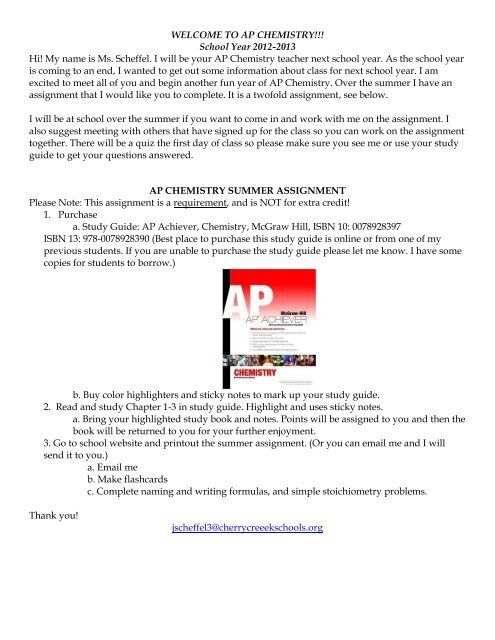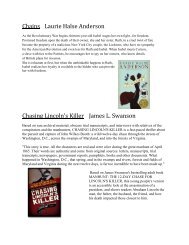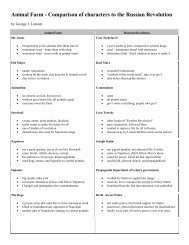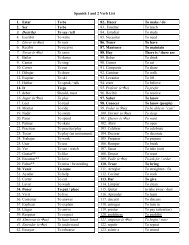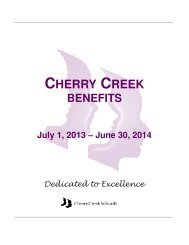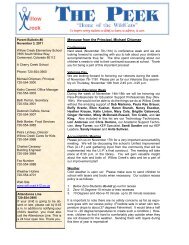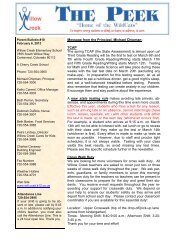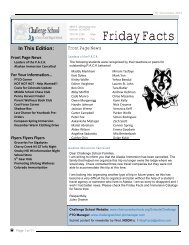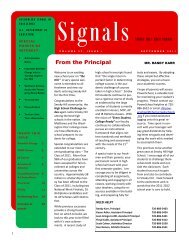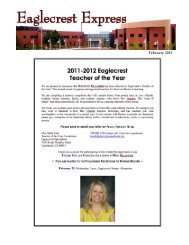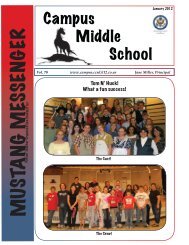ap chemistry summer assignment - Cherry Creek School District
ap chemistry summer assignment - Cherry Creek School District
ap chemistry summer assignment - Cherry Creek School District
Create successful ePaper yourself
Turn your PDF publications into a flip-book with our unique Google optimized e-Paper software.
WELCOME TO AP CHEMISTRY!!!<br />
<strong>School</strong> Year 2012-2013<br />
Hi! My name is Ms. Scheffel. I will be your AP Chemistry teacher next school year. As the school year<br />
is coming to an end, I wanted to get out some information about class for next school year. I am<br />
excited to meet all of you and begin another fun year of AP Chemistry. Over the <strong>summer</strong> I have an<br />
<strong>assignment</strong> that I would like you to complete. It is a twofold <strong>assignment</strong>, see below.<br />
I will be at school over the <strong>summer</strong> if you want to come in and work with me on the <strong>assignment</strong>. I<br />
also suggest meeting with others that have signed up for the class so you can work on the <strong>assignment</strong><br />
together. There will be a quiz the first day of class so please make sure you see me or use your study<br />
guide to get your questions answered.<br />
AP CHEMISTRY SUMMER ASSIGNMENT<br />
Please Note: This <strong>assignment</strong> is a requirement, and is NOT for extra credit!<br />
1. Purchase<br />
a. Study Guide: AP Achiever, Chemistry, McGraw Hill, ISBN 10: 0078928397<br />
ISBN 13: 978-0078928390 (Best place to purchase this study guide is online or from one of my<br />
previous students. If you are unable to purchase the study guide please let me know. I have some<br />
copies for students to borrow.)<br />
b. Buy color highlighters and sticky notes to mark up your study guide.<br />
2. Read and study Ch<strong>ap</strong>ter 1-3 in study guide. Highlight and uses sticky notes.<br />
a. Bring your highlighted study book and notes. Points will be assigned to you and then the<br />
book will be returned to you for your further enjoyment.<br />
3. Go to school website and printout the <strong>summer</strong> <strong>assignment</strong>. (Or you can email me and I will<br />
send it to you.)<br />
a. Email me<br />
b. Make flashcards<br />
c. Complete naming and writing formulas, and simple stoichiometry problems.<br />
Thank you!<br />
jscheffel3@cherrycreeekschools.org
Once you have opened and printed out the <strong>summer</strong> homework…<br />
Please email me. I would like to start an email list for all those who are<br />
registered for AP Chemistry.<br />
jscheffel3@cherrycreekschools.org<br />
Welcome to AP Chemistry! Most of you already have a background in <strong>chemistry</strong> from your Chemistry or<br />
Honors Chemistry class, but AP Chemistry is very different. Rather than memorizing how to do particular<br />
types of problems, you must really understand the <strong>chemistry</strong> and be able to <strong>ap</strong>ply it to all sorts of different<br />
situations.<br />
It is not all about memorization; however, having these items memorized is essential for success in learning<br />
the concepts covered in the course. Make flashcards, have your friends and family quiz you, take the lists with<br />
you on vacation, or do whatever it takes to get this information firmly planted in your head. Do not wait until<br />
the night before school begins.<br />
NO LATE ASSIGNMENTS WILL BE ACCEPTED!!!<br />
AP CHEMISTRY FIRST WEEK QUIZ<br />
Polyatomic Ions: Used for Naming Ionic Compounds and Acids (MAKE FLASHCARDS)<br />
Name Symbol/Charge Name Symbol/Charge<br />
ammonium NH4 +1 carbonate CO3 -2<br />
acetate C2H3O2 -1 chromate CrO4 -2<br />
perbromate BrO4 -1 dichromate Cr2O7 -2<br />
bromate BrO3 -1 peroxide O2 -2<br />
bromite BrO2 -1 oxalate C2O4 -2<br />
hypobromite BrO -1 selenite SeO4 -2<br />
perchlorate ClO4 -1 thiosulfate S2O3 -2<br />
chlorate ClO3 -1 sulfate SO4 -2<br />
chlorite ClO2 -1 sulfite SO3 -2<br />
hypochlorite ClO -1 phosphate PO4 -3<br />
periodate IO4 -1 phosphite PO3 -3<br />
iodate IO3 -1 borate BO3 -3<br />
iodite IO2 -1 carbonate CO3 -2<br />
hypoiodite IO -1 chromate CrO4 -2<br />
cyanide CN -1 dichromate Cr2O7 -2<br />
dihydrogen phosphate H2PO4 -1 peroxide O2 -2<br />
hydrogen carbonate HCO3 -1 oxalate C2O4 -2<br />
hydrogen sulfate HSO4 -1 selenite SeO4 -2<br />
hydrogen sulfite HSO3 -1 thiosulfate S2O3 -2<br />
hydrogen sulfide HS -1 sulfate SO4 -2<br />
hydroxide OH -1 sulfite SO3 -2<br />
nitrate NO3 -1 phosphate PO4 -3<br />
nitrite NO2 -1 phosphite PO3 -3<br />
permanganate MnO4 -1 borate BO3 -3<br />
thiocyanate SCN -1
START of AP Chemistry Summer Homework<br />
Part I: Chemical Formulas<br />
1. Write the formulas for the following: 2. Name each of the following:<br />
a. barium sulfate__________________________ a. CuSO4__________________________________<br />
b. ammonium chloride_____________________ b. PCl3____________________________________<br />
c. chlorine monoxide_______________________ c. Li3N___________________________________<br />
d. silicon tetrachloride______________________ d. BaSO3__________________________________<br />
e. magnesium fluoride______________________ e. N2F4___________________________________<br />
f. sodium oxide____________________________ f. KClO4__________________________________<br />
g. sodium peroxide________________________ g. NaH___________________________________<br />
h. copper (I) oxide_________________________ h. (NH4)2Cr2O7____________________________<br />
i. zinc sulfide_____________________________ i. HNO2__________________________________<br />
j. potassium carbonate_____________________ j. Sr3P2____________________________________<br />
k. hydrobromic acid_______________________ k. Mg(OH)2_______________________________<br />
l. perchloric acid__________________________ l. Al2S3___________________________________<br />
m. lead (II) acetate________________________ m. AgBr__________________________________<br />
n. sodium permanganate___________________ n. P4O10___________________________________<br />
o. lithium oxalate__________________________ o. HC2H3O2_______________________________<br />
p. potassium cyanide______________________ p. CaI2____________________________________<br />
q. iron (III) hydroxide______________________ q. MnO2__________________________________<br />
r. silicon dioxide__________________________ r. Li2O____________________________________<br />
s. nitrogen trifluoride______________________ s. FeI3____________________________________<br />
t. chromium (III) oxide_____________________ t. Cu3PO4_________________________________<br />
u. calcium chlorate________________________ u. PCl5___________________________________<br />
v. sodium thiocyanate_____________________ v. NaCN__________________________________
Part II: Stoichiometry<br />
Show all of your work for the following problems.<br />
1. Find the mass % of nitrogen in each of the following compounds:<br />
a. NO<br />
b. NO2<br />
c. N2O4<br />
d. N2O<br />
2. Benzene contains only carbon and hydrogen and has a molar mass of 78.1 g/mol. Analysis shows the<br />
compound to be 7.74% hydrogen by mass. Find the empirical and molecular formulas of benzene.<br />
3. Calcium carbonate decomposes upon heating, producing calcium oxide and carbon dioxide.<br />
a. Write the balanced chemical equation for this reaction.<br />
b. How many grams of calcium oxide will be produced after 12.25 g of calcium carbonate is completely<br />
decomposed?<br />
c. What is the volume of carbon dioxide gas produced when 12.25 g of calcium carbonate is<br />
decomposed at STP?<br />
4. Hydrogen gas and bromine gas react to form hydrogen bromide gas.<br />
a. Write the balanced chemical equation for this reaction.<br />
b. 3.20 g of hydrogen react with 9.50 g of bromine gas. Which is the limiting reactant?<br />
c. How many grams of hydrogen bromide gas can be produced using the amount in (b)?<br />
d. How many grams of excess reactant are left unreacted?<br />
5. When ammonia gas, oxygen gas and methane gas (CH4) are combined, the products are hydrogen cyanide<br />
gas and water.<br />
a. Write the balanced chemical equations for this reaction.<br />
b. Calculate the mass of each product produced when 225.00 g of oxygen gas is reacted with an excess<br />
of the other two reactants.<br />
c. If the actual yield of the experiment in (b) is 105.00 g of HCN, calculate the percent yield.


